![]()
![]()
![]()
Use LEFT and RIGHT arrow keys to navigate between flashcards;
Use UP and DOWN arrow keys to flip the card;
H to show hint;
A reads text to speech;
81 Cards in this Set
- Front
- Back
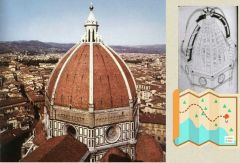
|
Fillipo Brunelleschi
Dome of the Duomo 1420-1436 The symbol of Florence. |
|
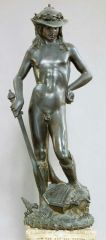
|
David
Donatello 1420/60s bronze This shows David as a nude adolescent, standing and contemplating over the head of Goliath. He holds the sword and stands contraposse. He hasn't quite grown into himself. |
|

|
(left to right)
Flippo Brunelleschi Sacrifice of Issac 1401 gilded bronze Lorenzo Ghiberti Sacrifice of Issac 1401 gilded bronze This was a competition, both of which covered the subject of Issac's sacrifice story. Flippo's Issac's head is turned away from Abraham so he doesn't have to look, so he can just get it over with. It's the moment where the angel has stopped his hand. The servants are just hanging out while there's choas above. Lorenzo's has Issac and Abraham looking in each others eyes like they're in this together. Issac is heroically nude to show his bravery. It's the moment where the angel is about to stop him. Both have a ram ready. Both have servants hanging out. |
|
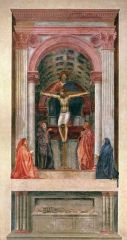
|
Masaccio
Trinity with the Virgin, St John, and donors Church of Santa Maria Novella 1425-28 fresco Early example of linear perpective. God holds up the arms of the cross. Dove on there. Mary and John at Jesus' sides. Donors at the bottom in prayer. Trinity in Jesus, Holy Spirit, and God. Skeleton at bottom with inscription "what I was, you are; what I am, you will be." This is, a reminder that life is temporary and everyone dies. |
|
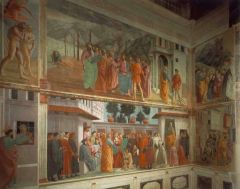
|
Brancacci Chapel (Santa Maria del Carmine) done entirely of fresco paintings depicting sces from Jesus' life as well as the tempation and expulsion of Adam and Eve.
Masolino, Masaccio, and Filippino Lippi (both hired by Masolino because he wouldn't have been able to make the deadline otherwise). Masaccio painted the taxes and expulsion scenes, Masolino painted the tempation and was outshined by the former. |
|

|
Masaccio
Expulsion from Garden of Eden Branacci Church 1427 Masaccio looked at Roman copies of Greek sculpters as reference material for Eve's figure. She covers herself in shame and wails. Both her and Adam are naked and ashamed. Adam hides his face in grief and shame, crying. They walk away from the Garden doors as an angel sees them out. Lines show God's voice sending them off. |
|

|
Masaccio
The Tribute Money Branacci Church 1427 A conflated painting depicting Christ getting hassled about taxes, telling Peter to go fishing, Peter catching a fish with a shekel in its mouth, and paying. It's out of order so Vhrist can be in the center. Doing this shows his importance without resorting to making him the largest (moving away from that old-school idea). Disciples don't know what to do. The halos lay more naturally on their heads to show space. Peter can't believe what Jesus is telling him to do. Tax collector dressed luke a Florence man and can't believe he's getting the money. Tree leaves were likely painted a secco but weared off. |
|
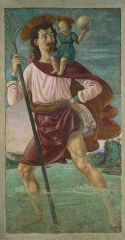
|
Tells the story of how Saint Christopher carried a child across the river on his should. His shoulders became heavier and heavier until they reached their destination. The child revealed himself as Christ and tild Christopher that he just beared the weight if the world on his shoulders. The orb is "the world." A day (giornata) was spent painting Christ because he's the most important. Fish painted in when everything is dry (a secco).
|
|
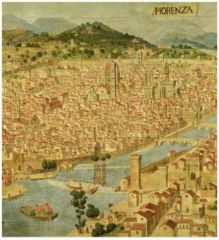
|
g
|
|
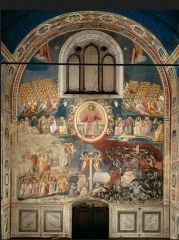
|
Last Judgement
Scrovevegni Chapel dedicated 1304 Giotto Jesus throned cast those at his right in heaven and those at his left in hell. Based on the bible passage that those at his right would recieve blessings and those at his left would recieve condemnation. Heaven is peaceful and orderly; hell is dark and choatic. A river of blood surrounds hell while the devil sits on a dragon and eats the damned. Angels hold the cross. The twelve desciples sit. Angels play trumpets and close the scroll of time (sun and moon). Saints on border. The Scroevegni present the chapel to Mary (with deacon). |
|
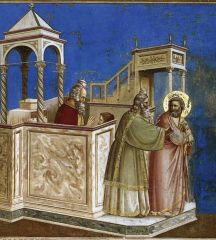
|
Expolsion of Joachim from the Temple
Scrovegni Chapel Padua dedicated 1304 Giotto Joachim and Anna were the parents of Mary who had grown old yet not had children (despite a divine promise they would). Because of this an arrogant and unsympathetic priest kicked them out of the temple. Giotto was clearly a master of expressions. Joachim looks crushed and humiliated. He craddles a lamb like a baby to show his gentleness. |
|
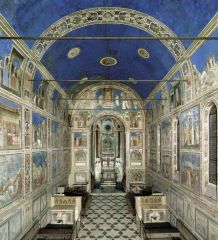
|
Giotto
Scrovegni Chapel (the Arena Chapel) Padua dedicated 1304 Saints on the ceiling. All over are paintings depicting the life of Mary, since the chapel was dedicated to her. This includes the story of Mary's parents and how she was concieved. |
|
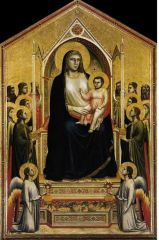
|
Giotto
Virgin and Child in Majesty 1310 Tempera on panel Moving away from the art style. Baby Jesus is little man. Angels holding up the throne. Deep blue robe for Mary. Innovative things that make this different from other VaCTiM pictures at the time: Throne is made of stone, precious stones, and marble; The space is 3D rather than 2D; Mary has weight and mass; It's all more realistic looking; No tilted head; hands aren't as bizarre. |
|
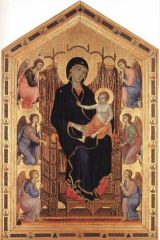
|
Duccio
Virgin and Child in Majes 1285 Tempera on panel Face is turned in a way so Mary's eye is in the enter of her halo. Angels hold up the throne. Deep blue clothes because it's Mary's "thing." Baby Jesus is like a little man to show he's not just a baby but an important and spiritually mature being. Mary presents him as a savior. She's serious because she knows what will happen to him. Fingers are smooth and knuckless because it's also a "thing." Saints on the border. Gold leaf. |
|
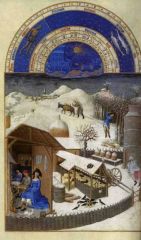
|
Limbourg Brothers
The Very Sumptuous Hours of John, Duke of Berry: February 1412-16 Illumination on vellum Calendar page specifically painted for this Duke. These people are clearly poor. Only a common woman would show her legs. The man is chopping wood with his coat tucked in his pants. The roof of the buildingnis damagef. Bees have homes for harvesting. There's a dove house. Crows are eating. A donkey is going to the city for supplies. It's obviously winter because of the snow, the trees, everyone inside. Everything is pushed to the front to show distance and convey space. Things get smaller and less detailed the further they are. Atmospheric perspective. |
|

|
Jan van Eyck
Double Portrait of Giovanni Arnolfini and his wife 1434 oil on panel This painting was composed to show off Giovanni's wealth and success from his merch job. They're in the bedroom, which is the most furnished house. There's so much red, which was an expensive dye made from an imported plant. There are oranges and a Turkish rug, also imported. There's a little German breed of dog, affenpinscher, also imported, which is smack in the middle as a symbol of marriage fidelity. The wife has a sheek hair style, with a high white forehead, small breast, a swayed posture, and a round stomach. This shows her wealth but also her ideals as a woman. Her headcovering (indicating she's married) is white, and her dress trim is made of squirel underside, also showing her wealth. Giovanni has modest but expensive clothes made of velvet and fur, shaved head. His faith is shown in the amber prayer beads and pictures of Jesus life on the mirror (which also shows wealth). Spring outside. Sandals to keep his feet out of street nastiness. Signature states that Juan van Eynk was "there" as in, in his house, which is even more impressive than just having a big-time painter paint for you. The fact Giovanni could afford Jan van Eyck also shows wealth. Wife is of equal height and their both kinda in thr center; they're equally important. |
|

|
The Annunciation Tripych
1425-30s South Neatherlandish oil on panel Donor and wife (painted on later) in one wing. Guy serves as a Gabriel since he's a messenger opening a door. Mary is absorbed in reading a religious book (because it's covered; she won't dirty it with her hands) and Gabriel is about to announce himself. There's the tension of it being right before a big moment; the viewer imagines a reaction. Perpective is semi-realistic; but distorted so you see everything. Spanish vase shows she's well off. Book and book bag. Candle going out to show a big event has just occurred. Baby Jesus with cross is about to slide into Mary's ear (because it was an opening. Water to show her purity. Windows with shutters to keep weather and animals out. Mary's kinda sitting on the ground to show her humility. Atmospheric perspective. Joseph is a grizzly old man making mouse traps. |
|
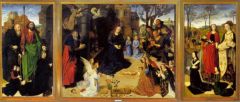
|
Hugo van der Goes
Adoration of the Shepards (Portinari Alterpiece). 1474-1476 oil on wood Angels and sheperds gather around the new baby Jesus, who lays in a bed of wheat since He's "the bread of life." An ox is very attentive, to symbolize those who are spiritually attentive, and he donkey goes about his business, to symbolize those who are spiritually ignorant. |
|
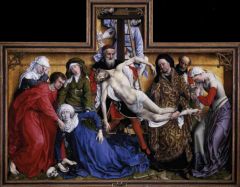
|
Rogier van der Wayden
Descent from the Cross 1440 oil on panel Jesus is dead and being taken down to be buried before the Sabbath. Mary Madeligne (jar) weeps. Mary has fallen in mourning, she's white, crying, and swollen in grief. John the baptist holds Mary. She's positioned similarily to Jesus to show their connection as mother and son. Bows/arrows in the corners because the donors were makers. |
|
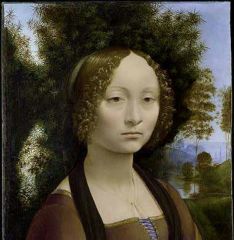
|
Leonardo da Vinci
Ginevra de' Benci 1474/1478 oil on panel Engagement announcement for the daughter of a wealthy banker. It was customary to have the girl in full profile with fancy clothes and elaborate hairstyles with various jewels. She is modestly dressed, without decoration, with a regular hairstyle. This is to show her personality. There's usually a window in these kind of pictures but he did a nature scene with a type of tree in that symbolizes chasity, so you know she is a virgin for her marriage. Profile us customary but he had her slightly turned. She us serious, which was customary because it wasn't dignified to smile. Hazy background and smokey eyes. She looks at the viewer to engage them. The back has symbols of beauty and virtue, with a Latin motto meaning beauty comes from virtue, so Ginevra's modesty and virtue comes from her beauty. |
|
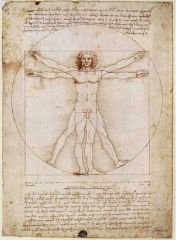
|
Vitruvian Man
1499 ink on paper A sketch in which the length of a man's armspan is equal to his height, and circle and square are used to help with the proportion. Meant as a sketch, not for others to see. |
|
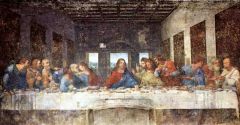
|
Leonardo da Vinci
Last Supper Refectory, Monastery of Santa Maria delle Grazie, Milan 1495-1498 Leonardo tried mixing plaster with oil, but the plaster dried much sooner than the oil so it started flaking almost immediately. Jesus just announced that someone would betray him, but he's totally calm because he knows it has to happen. Everyone is freaking out. One group is all "huh" while the other is all "what did he just say!?" and the other is totally disheartened by the news. Peter is being patted on the back and questioned, and John's all sleepy. Judas is seperated from the group in that he's not surprised and taking food l, which is how he'll be identified. Usually Jydas is on the other side of the table but not this side. |
|
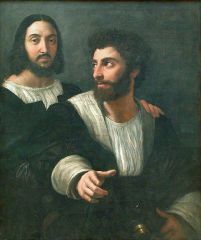
|
Rapheal
Self-portrait with a Companion 1518-1519 Oil on canvas Rapheal and unknown friend painted just before his death. Innovative through: Rapheal's "thing" is the foreshortening with the figure pointing; Friend looking at Rapheal instead of the viewer and having dialogue with him; the detailed texturization; flat background color; neautral colors; informal. |
|
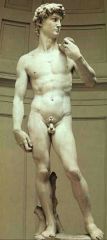
|
Michelangelo
David 1504 Marble Collosal statue meant to be seen from hih up and afar but Michelangelo went all out on the details anyway. Contrapose. Captures the moment in which David is facing down Goliath, looking very intense as he accepts what he's about to do. Made because David is Florence's mascot and he originally would have been facing Florence's rivals (whatever city Italian city they were rivaled against)in the statue's original placement. Detailed veins and tendons. Though David was an adolescent in the story, Michelangelo sculpted David as a strong beautiful male. This is just like the ancient Greek thinking of how one's looks reflect who they are on the inside, and how power is shown through physical power. David's hand looks large but only because it would look proportional from where it was meant to be placed. |
|
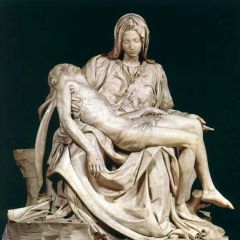
|
Michelangelo
Pieta 1499 St. Peter's Basilica, Vatican Shows Mary holding Jesus after his death. This was a popular artistic concept in other parts of Europe but not Italy, so Michelangelo was bringing it over. It's the only work he ever put his signature (on the sash looking thing between her breast) on but the reasons for that aren't solid. Mary is made to be much larger than an actual woman so Michelangelo could capture this moment of Mary holding Jesus on her lap as if he were still a child. Both Mary and Jesus' expression is peaceful because they knew this had to happen, and that momentary torment was nothing compared to his eternal peace. Unlike with other works, Jesus doesn't have a gruesomely wounded body. It's more focused on how the moment has passed and now there's just peace. |
|
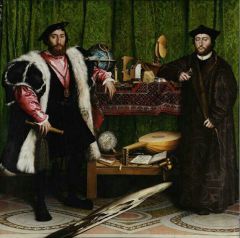
|
Hans Holbien the Younger
The French Ambassadors 1533 Oil on wood panel Jean de Dinteville Georges de Selve Ambassador has extravagant velvet clothing with fur trim, a madaleion showing him a member of the most prestegious order of the time, with a dagger with his age (29). Church man with more modest but still very expensive clothes, holding glasses and against a book with his age (25). Split virtically it's a life of adventure and a life of learning. A Turkish rug to show wealth, (on top of table to show off and stay clean). It can be horizontally it's celestial vs earthly things. Celestial globe, sun dial, ect. Then below is globe of earth, music book with a hym written by Martin Luther. An stringed instrument with a broken string,l, showing discord in the church and how it was dividing at the time. Luxurious green curtains to show how life should be lived, but Jesus us in the corner to remind you that it's only temporary and you should remember what's important. Skull is distorted when looking at all the stuff. When you look at an angle you can see the skull but nothing else. It shows death is always present but you can't see it when you're looking at everything else. One point perspective on the marble cut flooe, which is based off thw floor of an actual chapel. |
|
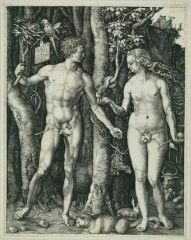
|
Adam and Eve
Albrecht Durer Germany, 1471-1528 Engraving; 9 7/8 x 7 7/8 in Four humors choleric (blood), sanguine (urine), phlegmatic (flem), melancholic (black flem/feces). Midevil thinking is when these humors were balanced, the human body was healthy. Too much or too little they get sick. The cat (blood), ox (flem), rabbit (blood), and yak (crap) represents these humors. It's paradise, it's harmony. The mouse and cat shows hunting hasn't started. The snake represents sneaking intellect while the parrot is good intellect. Adam and Eve's anatony are based off Greek sculptures. Adam's figureis identical to the model, even doen to the curly hair but it's more muscular. Some modesty in the leaves covering tgeir genitals, but they've yet to become ashamed of their own nudity. Eve hids one "apple" and leans in as the snake gives her another. A signature. Ram and mountain as fun details. |
|
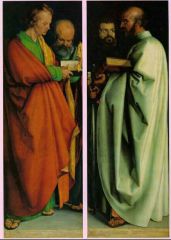
|
Durer
Four Apostles John, Paul, Peter, Mark 1526 Fat guy is John, the bald brunette is Paul, the sketchy looking one with thinning hair is Mark, and the round one with the grey beard is Peter. They're holding books and discussing. He had made th8s for a council in a time that protestants were destroying art. Durer, as an artist of faith, was against this. He painted this because he wanted to, to show that we there was still room for art in their daily lives. Not to be divine but start discussion. |
|
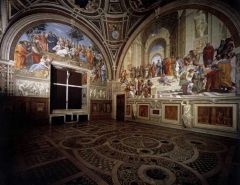
|
Stanza della Segnatura
Parnassus and the School of Athens 1510-1511 Vatican, Rome What looks like sculpters and marble is actually paint. Rapheal, along with many other artist, were lured to Rome by the Pope. He wanted to show his importance as a religious and political figure by dominating art. Rapheal was hired to paint this room and tapestry for special events. |
|

|
Rapheal
School of Athens 1510-1511 Vatican, Rome The school of Athens isn't a real place but rather the idea of a Utopia where the cream of the crop gather. A statue of the goddess Athena is at one side and Apollo at the other to represent wisedom and art. One point perspective is used on the building, which was vaguely inspired by the New St Peter's Basillica that was being built at the time. At the center are Plato (pointing up to show he thinks about the above things), and Aristotle (pointing down to show he's more earthbound). Plato is painted to look like Leonardo. The crowd makes up lines and is full of mathmaticians and philosphers. One is painted like a great architech of the time and another (added later) looks like Michelangelo. This is his way of relating a utopia of geniuses to Rome at the time, since so many genius artist were being gathered there by the Pope. Rapheal even painted himself in the crowd to show he was part of it. |
|

|
Michelangelo
Sistine Chapel Cieling, Genesis 1508-1512 |
|
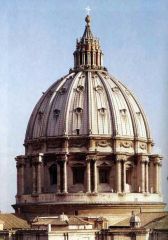
|
Michelangelo
Dome of The Basiluca of St. Peter Vatican, Rome 1564 |
|
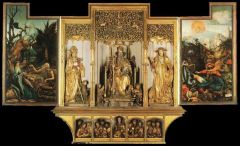
|
Mattias Grunewald
Isenheim Alterpiece (third view) St Paul and Anthony in the Desert; The Temptation of St Anthony 1515 oil on wood, stone St Anthony chatting with St Paul and their so into their theological conversation that they forget to eat and a bird brings them bread. I the other Anthony is being beaten and seduced by women to show all the temptation and torture he's expirenced in life. Someone with St Anthony's fire is in the corner with scritpure to show he's still expected to keep faithful. |
|
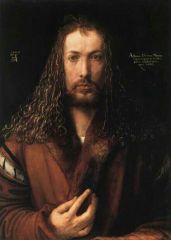
|
Self-Portrait in a Fur-Collared Robe
Albrecht Durer 1500 Oil on limewood panel A self-portrait Durer made at age 28. He writes that he made this at that age and shows off the first logo invented because people kept trying to steal his art. He knows he's a genius, good-looking, and well-off, that he's a big deal and shows it off but he kinda looks like Jesus to sh8w there's someone better than he. |
|
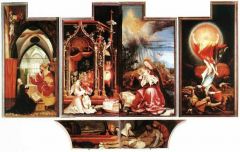
|
Mattias Grunewald
Isenheim Alterpiece, 2nd view Annunciation, Nativity, Resurrection Oil on panel 1515 Gabriel announces to Mary and she turns away because she feels unworthy. Angels play music for Mary's new baby. Jesus is ressurected and becomes light itself, and forms a sun at night. So impossible it must be divine. Roman soldiers freak out because the sound and light is too much. |
|
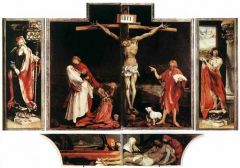
|
Mattias Grunewald
Isenheim Alterpiece (first view) 1515 Oil on wood: Wings Closed Jesus's body is twisted, his feet swollen, and sores cover his skin. This makes him a more sympathetoc image to those with St Anthony's fire. He's dead, as everyone who looks at it will soon be dead. It reminds tje dying viewer that he Jesus suffered too, that he specifically suffered and died so they could have salvation. Mary Madaleine (jar) prays and cries out. A lamb holds a cross and bleeds into a challace so remind them that the lamb of god bled for them, a reference also to the mass. It stands next to John the Baptist. St Anthony and St Sebastian at each side as patrons saints of suffering believers, since St Anthony (which the hospital was dedicated to) suffered much trisl and temptation, and St Sebastian who was shot full of arrows. Mary collapse in disciple John's arms in grief. Jesus isn't centered because the cross covers the opening. |
|
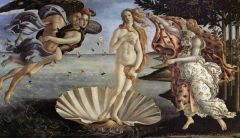
|
Sandro Botticelli
Birth of Venus Tempera on canvas 1484-1486 Venus ws born from the sea foam that resulted in Zues misfireing his baby-batter into the ocean. She is nude, though there's a sense of nakedness in the modesty of covering herself and Mother Earth attempting to cover her. |
|
|
I primi lumi
|
"First Lights"
|
|
|
manuscript
|
Handwritten/Handmade medeviel book or document.
|
|
|
parchment & vellum
|
Paper made of treated animal skin. Vellum was specifially made from an infant or unborn animal and is the finer type of parchment.
|
|
|
Labours of the month
|
12 scenes taking place at different months of the year.
|
|
|
tempera
|
Fast-trying paint made with colored pigment mixed with a binder, often egg yoke.
|
|
|
Enrico Scrovegni
|
A banker who took insurence. This was considered a sin at the time so the Scrovegni family dedicated a chapel to Mary in hopes she would speak to God on Enrico's behalf.
|
|
|
usury
|
Taking insurance, basically. Considered a terrible sin back in the day. The Scrovegni family even dedicated a chapel to Mary in hopes she could help save a family member who was a user.
|
|
|
Fresco
|
Painting technique in which the artist would mix plaster with paint and put it on the wall, making the painting part of the wall itself.
|
|
|
Foreshortening
|
Rendering a 2D object or figure at an angle to give the illusion of 3D space.
|
|
|
Stella Maris
|
"Star of the Sea" or "Our Lady," a name of the virgin Mary that emphasises her role as a guide to hope for humanity.
|
|
|
Alterpiece
|
Artwork of religious subject suspended in a frame behind the alter of a church.
|
|
|
Predella
|
A platform that an alter stands on.
|
|
|
Ciborium
|
Holds the bread during mass.
|
|
|
Florin
|
Currency in Florence.
|
|
|
Disegno
|
Italian word for drawing or design.
|
|
|
Atmospheric perspective
|
The affect of far away objects getting smaller, less detailed, or even hazier.
|
|
|
Linear perspective
|
A visual affect where parallel lines and a vanishing point are used to create the illusion of 3D space.
|
|
|
Vanishing point
|
Where parallel lines intersect.
|
|
|
Gilded
|
Thinly covered with gold leaf.
|
|
|
Quatrefoil
|
Decorative framework in Christian architecture which consist of four overlapping circles.
|
|
|
Herringbone pattern
|
An arrangment of rectangles.
|
|
|
4 Cardinal Virtues
|
Justice, prudence, patience, fortitude.
|
|
|
Duomo
|
Italian Cathedral church.
|
|
|
Diptych
|
Two flate planes attatched by a hinge. Fand fold open or closed.
|
|
|
hurdy-gurdy
|
Stringed instrument.
|
|
|
St. Anthony's fire
|
Ergotism, a disease caused from mold. The high fever and torment of this disease ws named after the torment St Anthony expirenced in his own life.
|
|
|
Kunst;konnen
|
The German word for art rooted in the German "to know." Coined by Albrecht Durer.
|
|
|
Utopia
|
A perfect (nonexistent) place
|
|
|
Indulgences
|
Money paid to the Catholic church to insure the payer would spend less time in purgatory.
|
|
|
Martin Luther
|
Major reformer who broke away from the Catholic church.
|
|
|
Iconoclasm
|
The destruction of religious images.
|
|
|
Vinci
|
Where Leonardo is from.
|
|
|
Mona
|
A respectful suffix. Like "Mrs" or "lady."
|
|
|
Three-quarter view
|
When the human figure or head is between a frontal and profile view.
|
|
|
Stumato
|
A smoky look in Italian Renaissance paintings. Well loved by Leonardo da Vinci.
|
|

|
Fra Carnevale
The Ideal City, 1480-1484 oil on panel |
|
|
arriccio
|
thick layer of plaster
|
|
|
sinopia
|
prepatory drawing (2nd stage)
|
|
|
giornata
|
a day's work (4th step)
|
|
|
a secco
|
painting on dried plaster. (last)
|
|
|
affenpinscher
|
a little German breed of dog
|
|
|
Pattens
|
High sandals that would keep someone's feet out of the waste in the street.
|
|
|
deacon
|
ordained minister of an order, below a priest.
|
|
|
intonacco
|
thin layer of plaster (third step)
|

